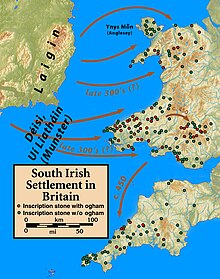Ogham stones of Wales
The 35 Secured Oghamstones of Wales are the largest number of Oghamstones in any region outside of Ireland . They are unevenly distributed at 32 in the southern half and only three in the Kingdom of Gwynedd in the north. The distribution is a consequence of the political development after the withdrawal of the Romans from Britain.
history
During the late 4th and beginning of the 5th century, a large group of Uí Liatháin and especially Déisi moved from Ireland to Great Britain and settled in Wales , Cornwall and on the Isle of Man in addition to the Scots ( Dalriada in Scotland ) . They ousted the Demetae ruling class in south Wales and founded the kingdoms of Dyfed and Brycheiniog .
There have always been Irish attacks on the north of Wales, particularly Anglesey and the Lleyn Peninsula (whose name is derived from Laigin: the men of Leinster ), but there was resistance in the late 4th and early 5th centuries the Irish incursions, led by Cunedda ap Edern (also Cunedda Wledig) (the founder of the kingdom of Gwynedd), and the Irish failed to gain control of any of the kingdoms in North Wales.
description
Over 20 stones are concentrated in the Kingdom of Dyfed (early 5th to early 10th centuries) which was the main center of Irish settlement in Wales. At least eight ogham stones have been found in Brycheiniog. There are also two ogham stones in Glywysing , which suggests that Irish settlement stretched far to the east. Three Ogham inscriptions, all in the territory of the Kingdom of Gwynedd, are from North Wales.
The Welsh ogham stones have been dated to the 5th and 6th centuries. Like most ogham stones in Cornwall and Devon , they have an inscription in Latin on the face of the stone, and in Ogham on the edge of the stone ( Lewannick Ogham stones ). Of the 35 stones in Wales, only five have no Latin inscription ( Efessangus stone ). In all cases, the inscription gives the name of a person, and possibly the name of the father or another family relationship of the person. In almost all cases, the person is male. In one case the Ogham inscription refers to a daughter.
See also
literature
- Damien McManus: A Guide to Ogam. To Sagart, Maynooth 1991, ISBN 1-870684-17-6 .
Individual evidence
- ↑ The Déisi were groups of people in early medieval Ireland. The term is derived from dies, which means "vassal". It denotes cross-clan groups that were initially vassals of a landowner. Déis later became a proper name for groups across Ireland. The groups listed under Deis had little or no clan affinity. The Expulsion of the Déisi is a medieval tale of the cycles of kings. It dates from around the 8th century, but only survived in later manuscripts. It tells the fictional story of the Déisi, groups who gained political power in parts of Ireland during the early Middle Ages.

